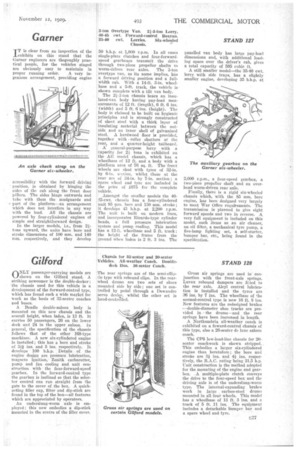Garner
Page 165

If you've noticed an error in this article please click here to report it so we can fix it.
IT is clear from an inspection of the exhibits on this stand that the Garner engineers are thoroughly practical people, for the vehicles staged are obviously easy to maintain in proper running order. A very ingenious arrangement, providing engine
accessibility with the forward driving
• position, is obtained by hinging the sides of the cab along the front door pillars. The sides hinge outwards and take with them the mudguards and part of the platform—an arrangement which does not interfere in any way with the load. All the chassis are Powered by four-cylindered engines of simple and straightforward design.
In the larger models, i.e., from 2tons upward, the units have bore lend stroke dimensions of 100 mm. and 140 aim. respectively, and they develop 50 b.h.p. at 1,800 r.p.m. In all cases single-plate clutches and four-forwardspeed g,earboxes transmit the drive through two-piece propeller shafts to worm-driven rear axles. The 3-ton overtype van, as its name implies, has a forward driving position and a fullwidth cab. With a 14-ft. 3-in, wheelbase and a 5-ft track, the vehicle is • shown complete with a tilt van body.
The 21-3-ton chassis bears an insulated-van body having pay-load measurements of 12 ft. (length), 6 ft. 6 ins. (width) and 5 ft. 6 ins. (height). The body is claimed to be built oxi. hygienic principles and is strongly constructed of sheet steel with a thick layer of insulating material between the outside and an inner shell of galvanized steel. A hardwood floor is provided, together with • roller shutters at the rear, and a quarter-height tailboard.
general-purpose lorry with a capacity for 21 tons is exhibited on the AE model chassis, which has a wheelbase of 12 ft. and a body with a platform area of 76 sq. ft. The -front wheels are shod with tyres of 32-in. by 6-in. section, whilst those at the i.ear are of 34-in. by 7-in. section; a spare wheel and tyre are included in the price of 1675 for the complete vehicle.
Amongst the smaller models the 4045-cwt chassis. has a four-cylindered unit 85 mm. bore and 130 mm. stroke ; it develops 45 b.h.p. at 2,200 r.p.m. The unit is built on modern lines, and incorporates Ricardo-typecylinder heads, a full pressure lubrication system and pump cooling. This model has a 12-ft. wheelbase and 5 ft. track; the height of the frame from the ground when laden is 2 ft. 3 ins. The panelled van body has large pay-load dimensions and, with additional loading space over the driver's cab, gives a total capacity of 595 cubic ft.
A still smaller model—the 35-40 cwt, lorry with side trays, has a slightly smaller engine, developing 35 b.h.p. at 2,000 r.p.m., a four-speed gearbox, a two-piece propeller shaft and an overhead worm-driven rear axle.
Finally, there is a rigid six-wheeled chassis which, with the 85 mm. bore engine, has been designed very largely to meet War Office requitements. The transmission is planned to give eight forward speeds and two in reverse. very full equipment is included on this model, such items as an air cleaner, an oil filter, a mechanical tyre pump, a five-lamp lighting set, a self-starter, bumper bar, etc., being found in the specification.








































































































































































































































































































































